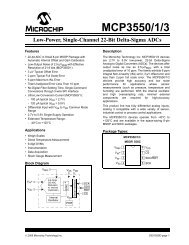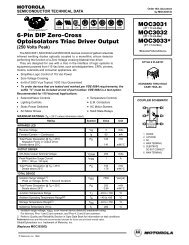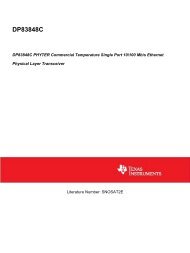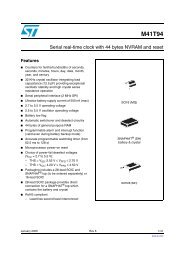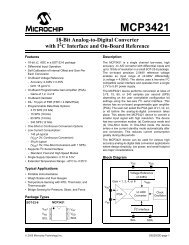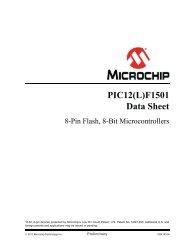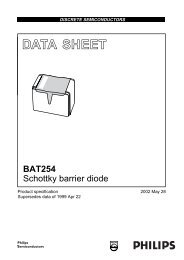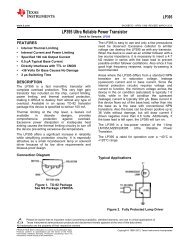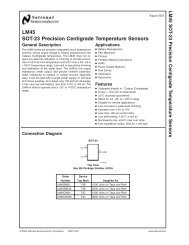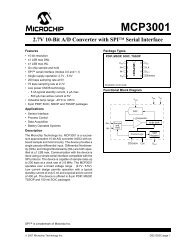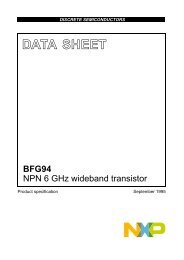ATxmega128A3U-MHR - E-LAB Computers
ATxmega128A3U-MHR - E-LAB Computers
ATxmega128A3U-MHR - E-LAB Computers
Create successful ePaper yourself
Turn your PDF publications into a flip-book with our unique Google optimized e-Paper software.
6.5 Program FlowAfter reset, the CPU starts to execute instructions from the lowest address in the flash programmemory ‘0.’ The programcounter (PC) addresses the next instruction to be fetched.Program flow is provided by conditional and unconditional jump and call instructions capable of addressing the wholeaddress space directly. Most AVR instructions use a 16-bit word format, while a limited number use a 32-bit format.During interrupts and subroutine calls, the return address PC is stored on the stack. The stack is allocated in the generaldata SRAM, and consequently the stack size is only limited by the total SRAM size and the usage of the SRAM. Afterreset, the stack pointer (SP) points to the highest address in the internal SRAM. The SP is read/write accessible in theI/O memory space, enabling easy implementation of multiple stacks or stack areas. The data SRAM can easily beaccessed through the five different addressing modes supported in the AVR CPU.6.6 Status RegisterThe status register (SREG) contains information about the result of the most recently executed arithmetic or logicinstruction. This information can be used for altering program flow in order to perform conditional operations. Note thatthe status register is updated after all ALU operations, as specified in the instruction set reference. This will in manycases remove the need for using the dedicated compare instructions, resulting in faster and more compact code.The status register is not automatically stored when entering an interrupt routine nor restored when returning from aninterrupt. This must be handled by software.The status register is accessible in the I/O memory space.6.7 Stack and Stack PointerThe stack is used for storing return addresses after interrupts and subroutine calls. It can also be used for storingtemporary data. The stack pointer (SP) register always points to the top of the stack. It is implemented as two 8-bitregisters that are accessible in the I/O memory space. Data are pushed and popped from the stack using the PUSH andPOP instructions. The stack grows from a higher memory location to a lower memory location. This implies that pushingdata onto the stack decreases the SP, and popping data off the stack increases the SP. The SP is automatically loadedafter reset, and the initial value is the highest address of the internal SRAM. If the SP is changed, it must be set to pointabove address 0x2000, and it must be defined before any subroutine calls are executed or before interrupts are enabled.During interrupts or subroutine calls, the return address is automatically pushed on the stack. The return address can betwo or three bytes, depending on program memory size of the device. For devices with 128KB or less of programmemory, the return address is two bytes, and hence the stack pointer is decremented/incremented by two. For deviceswith more than 128KB of program memory, the return address is three bytes, and hence the SP isdecremented/incremented by three. The return address is popped off the stack when returning from interrupts using theRETI instruction, and from subroutine calls using the RET instruction.The SP is decremented by one when data are pushed on the stack with the PUSH instruction, and incremented by onewhen data is popped off the stack using the POP instruction.To prevent corruption when updating the stack pointer from software, a write to SPL will automatically disable interruptsfor up to four instructions or until the next I/O memory write.After reset the stack pointer is initialized to the highest address of the SRAM. See Figure 7-3 on page 13.6.8 Register FileThe register file consists of 32 x 8-bit general purpose working registers with single clock cycle access time. The registerfile supports the following input/output schemes:• One 8-bit output operand and one 8-bit result input• Two 8-bit output operands and one 8-bit result input• Two 8-bit output operands and one 16-bit result input• One 16-bit output operand and one 16-bit result inputXMEGA A3U [DATASHEET]8386C–AVR–02/20139



